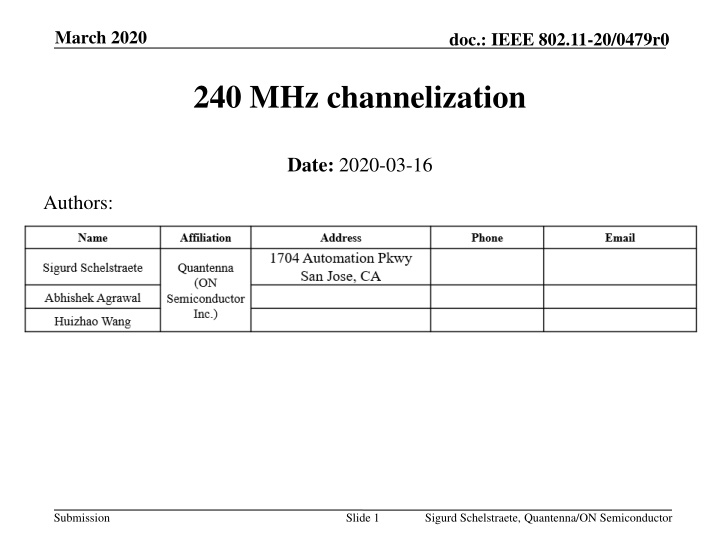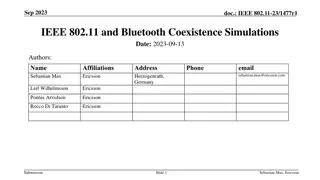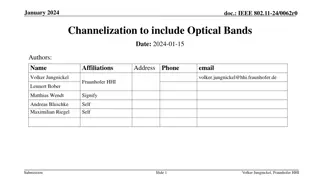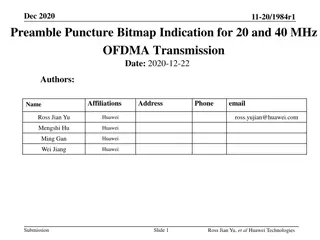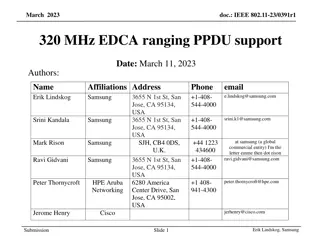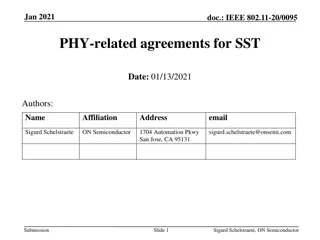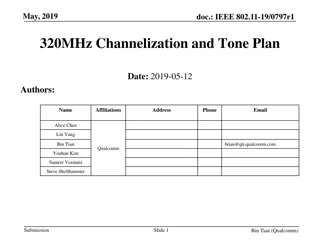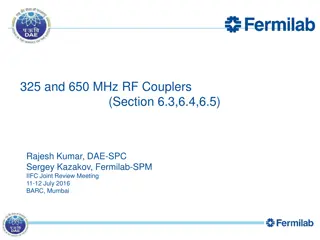IEEE 802.11-20/0479r0 240 MHz Channelization Options
The document discusses agreements on 240 MHz channelization in IEEE 802.11-20/0479r0, presenting three options: contiguous non-overlapping channels, any combination of three consecutive 80 MHz channels, and puncturing of a 320 MHz channel. Various considerations and questions are raised regarding the formation and location of 240 MHz channels, as well as the potential overlaps and combinations with other bandwidth channels.
Download Presentation

Please find below an Image/Link to download the presentation.
The content on the website is provided AS IS for your information and personal use only. It may not be sold, licensed, or shared on other websites without obtaining consent from the author.If you encounter any issues during the download, it is possible that the publisher has removed the file from their server.
You are allowed to download the files provided on this website for personal or commercial use, subject to the condition that they are used lawfully. All files are the property of their respective owners.
The content on the website is provided AS IS for your information and personal use only. It may not be sold, licensed, or shared on other websites without obtaining consent from the author.
E N D
Presentation Transcript
March 2020 doc.: IEEE 802.11-20/0479r0 240 MHz channelization Date: 2020-03-16 Authors: Submission Slide 1 Sigurd Schelstraete, Quantenna/ON Semiconductor
March 2020 doc.: IEEE 802.11-20/0479r0 240 MHz agreements A number of agreements have been reached on 240 MHz [1]: 802.11be supports 240 MHz and 160+80 MHz transmission Whether 240/160+80 MHz is formed by 80 MHz channel puncturing of 320/160+160 MHz is TBD 240/160+80 MHz bandwidth is constructed from three 80 MHz channels which include primary 80 MHz the tone plan of each 80 MHz segment is the same as HE80 in 802.11ax Various puncturing modes for 240 MHz Submission Slide 2 Sigurd Schelstraete, Quantenna/ON Semiconductor
March 2020 doc.: IEEE 802.11-20/0479r0 240 MHz channelization Agreements on 240 MHz do not indicate where to 240 MHz channels can be located Allowed channel numbers for a given BW are typically listed in Annex E Specifically: Can any three consecutive 80 MHz channels be combined into a 240 MHz channel? Should 160 + 80 MHz allow any combination of 160 MHz and 80 MHz channels? Submission Slide 3 Sigurd Schelstraete, Quantenna/ON Semiconductor
March 2020 doc.: IEEE 802.11-20/0479r0 240 MHz channelization Three options for 240 MHz channelization Option 1: Contiguous but non-overlapping channels Option 2: Any combination of three consecutive 80 MHz channels Option 3: puncturing of 320 MHz channel Submission Slide 4 Sigurd Schelstraete, Quantenna/ON Semiconductor
March 2020 doc.: IEEE 802.11-20/0479r0 Option 1: non-overlapping Similar to allocation for other BW channels Note: a 160 MHz channel may overlap with two 240 MHz channels Submission Slide 5 Sigurd Schelstraete, Quantenna/ON Semiconductor
March 2020 doc.: IEEE 802.11-20/0479r0 Option 2: any three contiguous 80 MHz Higher probability of having OBSS with different primary channel Not allowed for any other BW Submission Slide 6 Sigurd Schelstraete, Quantenna/ON Semiconductor
March 2020 doc.: IEEE 802.11-20/0479r0 Option 3: punctured 320 MHz channel Overlap possible within 320 MHz channel Submission Slide 7 Sigurd Schelstraete, Quantenna/ON Semiconductor
March 2020 doc.: IEEE 802.11-20/0479r0 160+80 MHz channelization Note that contiguous 160+80 MHz is essentially identical to 240 MHz Even if going with Option 1 , this mode could be used as a backdoor to creating overlapping 240 MHz channels NOTE: this is generally true for other BW as well Submission Slide 8 Sigurd Schelstraete, Quantenna/ON Semiconductor
March 2020 doc.: IEEE 802.11-20/0479r0 Summary 240 MHz channelization options Only non-overlapping 240 MHz channels Any three consecutive 80 MHz channels Any three consecutive 80 MHz channels within 320 MHz channel i.e. 240 MHz channel equals punctured 320 MHz channel In case of non-overlapping allocation, do we need additional restrictions on (contiguous) 160+80 MHz channel allocations? Submission Slide 9 Sigurd Schelstraete, Quantenna/ON Semiconductor
March 2020 doc.: IEEE 802.11-20/0479r0 Straw Poll 1 Which channel allocation for 240 MHz do you support? Option 1: Non-overlapping 240 MHz channels Option 2: Allow any three consecutive 80 MHz to form a 240 MHz channel Option 3: Punctured 320 MHz allocation Option 1: Option 2: Option 3: Submission Slide 10 Sigurd Schelstraete, Quantenna/ON Semiconductor
March 2020 doc.: IEEE 802.11-20/0479r0 Straw Poll 2 Should 160+80 MHz be disallowed if the 160 and 80 MHz are adjacent? Y/N/A: Submission Slide 11 Sigurd Schelstraete, Quantenna/ON Semiconductor
March 2020 doc.: IEEE 802.11-20/0479r0 References [1] Specification Framework for TGbe, IEEE 802.11- 19/1262R8 Submission Slide 12 Sigurd Schelstraete, Quantenna/ON Semiconductor
